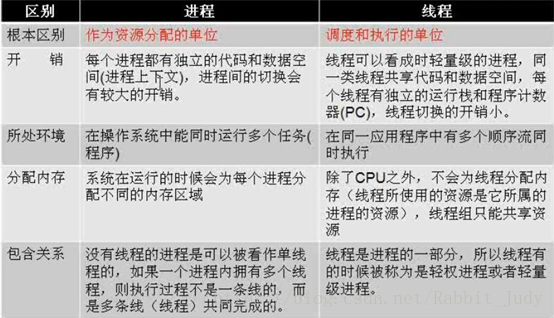线程的概念
程序:program,是一个静态的概念
进程:progress,是一个动态的概念
进程是程序的一次动态执行过程,占用特定的地址空间
每个进程都是独立的,由3部分组成cpu,data,code
缺点:内存的浪费,cpu的负担
线程:Thread,是进程中一个“单一的连续控制流程”/执行路径
线程又被称为轻量级进程
一个进程可拥有多个并行的线程
一个进程中的线程共享相同的内存单元/内存地址空间->可以访问相同的变量和对象,而且它们从同一堆中分配对象->通信、数据交换、同步操作
由于线程间的通信是在同一地址空间上进行的,所以不需要额外的通信机制,这就使得通信更简便而且信息传递速度也更快。
线程和进程的区别

Java中实现多线程
在Java中负责线程的这个功能的是Java.lang.Thread这个类
可以同创建Thread的实例来创建新的线程
每个线程都是通过某个特定Thread对象所对应的方法run()来完成其操作的,方法run()称为线程体
通过调用Thread类的start()方法类启动一个线程体
继承Thread类方式的缺点:那就是如果我们的类已经从一个类继承,则无法再继承Thread类
/**
* 模拟龟兔赛跑
1、创建多线程 继承 Thread +重写run(线程体)
2、使用线程: 创建子类对象 + 调用对象.start()方法 线程启动
* @author W.Sky
*
*/
public class Rabbit extends Thread {
@Override
public void run() {
//线程体
for(int i=0;i<100;i++){
System.out.println("兔子跑了"+i+"步");
}
}
}
class Tortoise extends Thread {
@Override
public void run() {
//线程体
for(int i=0;i<100;i++){
System.out.println("乌龟跑了"+i+"步");
}
}
}
通过Runnable接口实现多线程
优点:可以同时实现继承,实现Runnable接口方式要通用一些
1)避免单继承
2)方便共享资源,同一份资源,多个代理访问
/**
推荐 Runnable 创建线程
1)、避免单继承的局限性
2)、便于共享资源
使用 Runnable 创建线程
1、类 实现 Runnable接口 +重写 run() -->真实角色类
2、启动多线程 使用静态代理
1)、创建真实角色
2)、创建代理角色 +真实角色引用
3)、调用 .start() 启动线程
* @author W.Sky
*
*/
public class Programmer implements Runnable {
@Override
public void run() {
for(int i=0;i<1000;i++){
System.out.println("一边敲helloworld....");
}
}
}
public class ProgrammerApp {
public static void main(String[] args) {
//1)、创建真实角色
Programmer pro =new Programmer();
//2)、创建代理角色 +真实角色引用
Thread proxy =new Thread(pro);
//3)、调用 .start() 启动线程
proxy.start();
for(int i=0;i<1000;i++){
System.out.println("一边聊qq....");
}
}
}通过Callable接口实现多线程
优点:可以获取返回值
缺点:繁琐
import java.util.concurrent.Callable;
import java.util.concurrent.ExecutionException;
import java.util.concurrent.ExecutorService;
import java.util.concurrent.Executors;
import java.util.concurrent.Future;
/**
* 使用Callable创建线程
* @author W.Sky
*
*/
public class Call {
public static void main(String[] args) throws InterruptedException, ExecutionException {
//创建线程
ExecutorService ser=Executors.newFixedThreadPool(2);
Race tortoise = new Race("老不死",1000);
Race rabbit = new Race("小兔子",500);
//获取值
Future<Integer> result1 =ser.submit(tortoise) ;
Future<Integer> result2 =ser.submit(rabbit) ;
Thread.sleep(2000); //2秒
tortoise.setFlag(false); //停止线程体循环
rabbit.setFlag(false);
int num1 =result1.get();
int num2 =result2.get();
System.out.println("乌龟跑了-->"+num1+"步");
System.out.println("小兔子跑了-->"+num2+"步");
//停止服务
ser.shutdownNow();
}
}
class Race implements Callable<Integer>{
private String name ; //名称
private long time; //延时时间
private boolean flag =true;
private int step =0; //步
public Race() {
}
public Race(String name) {
super();
this.name = name;
}
public Race(String name,long time) {
super();
this.name = name;
this.time =time;
}
@Override
public Integer call() throws Exception {
while(flag){
Thread.sleep(time); //延时
step++;
}
return step;
}
public String getName() {
return name;
}
public void setName(String name) {
this.name = name;
}
public long getTime() {
return time;
}
public void setTime(long time) {
this.time = time;
}
public boolean isFlag() {
return flag;
}
public void setFlag(boolean flag) {
this.flag = flag;
}
public int getStep() {
return step;
}
public void setStep(int step) {
this.step = step;
}
}
线程的状态
新生状态、就绪状态、运行状态、阻塞状态、死亡状态
/**
* join:合并线程
* @author W.Sky
*
*/
public class JoinDemo01 extends Thread {
public static void main(String[] args) throws InterruptedException {
JoinDemo01 demo = new JoinDemo01();
Thread t = new Thread(demo); //新生
t.start();//就绪
//cpu调度 运行
for(int i=0;i<1000;i++){
if(50==i){
t.join(); //main阻塞...
}
System.out.println("main...."+i);
}
}
@Override
public void run() {
for(int i=0;i<1000;i++){
System.out.println("join...."+i);
}
}
}
Sleep模拟网络延时
/**
* Sleep模拟 网络延时 线程不安全的类
* @author W.Sky
*
*/
public class SleepDemo02 {
public static void main(String[] args) {
//真实角色
Web12306 web= new Web12306();
Web12306 web2 = new Web12306();
//代理
Thread t1 =new Thread(web,"路人甲");
Thread t2 =new Thread(web,"黄牛已");
Thread t3 =new Thread(web,"攻城师");
//启动线程
t1.start();
t2.start();
t3.start();
}
}
class Web12306 implements Runnable {
private int num =50;
@Override
public void run() {
while(true){
if(num<=0){
break; //跳出循环
}
try {
Thread.sleep(500);
} catch (InterruptedException e) {
e.printStackTrace();
}
System.out.println(Thread.currentThread().getName()+"抢到了"+num--);
}
}
}
线程基本信息

优先级:表达的是概率,不是绝对的先后顺序
/**
*
Thread.currentThread() :当前线程
setName():设置名称
getName():获取名称
isAlive():判断状态
* @author W.Sky
*
*/
public class InfoDemo01 {
public static void main(String[] args) throws InterruptedException {
MyThread it =new MyThread();
Thread proxy =new Thread(it,"挨踢");
proxy.setName("test");
System.out.println(proxy.getName());
System.out.println(Thread.currentThread().getName()); //main
proxy.start();
System.out.println("启动后的状态:"+proxy.isAlive());
Thread.sleep(200);
it.stop();
Thread.sleep(100);
System.out.println("停止后的状态:"+proxy.isAlive());
}
}
/**
* 优先级:概率,不是绝对的先后顺序
MAX_PRIORITY 10
NORM_PRIORITY 5 (默认)
MIN_PRIORITY 1
setPriority()
getPriority()
* @author W.Sky
*
*/
public class InfoDemo02 {
public static void main(String[] args) throws InterruptedException {
MyThread it =new MyThread();
Thread p1 =new Thread(it,"挨踢1");
MyThread it2 =new MyThread();
Thread p2 =new Thread(it2,"挨踢2");
p1.setPriority(Thread.MIN_PRIORITY); //设置优先级
p2.setPriority(Thread.MAX_PRIORITY);//设置优先级
p1.start();
p2.start();
Thread.sleep(100);
it.stop();
it2.stop();
}
}
线程同步
由于同一进程的多个线程共享同一片存储空间,在带来方便的同时,也带来了访问冲突这个严重的问题。Java语言提供了专门机制以解决这种冲突,有效避免了同一数据对象被多个线程同时访问。
由于我们可以通过private关键字来保证数据对象只能被方法访问,所以我们只需针对方法提出一套机制,这套机制就是synchronized关键字,它包括两种用法:synchronized方法和synchronized块。
/**
* 过多的同步方法可能造成死锁
* @author W.Sky
*
*/
public class SynDemo03 {
public static void main(String[] args) {
Object g =new Object();
Object m = new Object();
Test t1 =new Test(g,m);
Test2 t2 = new Test2(g,m);
Thread proxy = new Thread(t1);
Thread proxy2 = new Thread(t2);
proxy.start();
proxy2.start();
}
}
class Test implements Runnable{
Object goods ;
Object money ;
public Test(Object goods, Object money) {
super();
this.goods = goods;
this.money = money;
}
@Override
public void run() {
while(true){
test();
}
}
public void test(){
synchronized(goods){
try {
Thread.sleep(100);
} catch (InterruptedException e) {
e.printStackTrace();
}
synchronized(money){
}
}
System.out.println("一手给钱");
}
}
class Test2 implements Runnable{
Object goods ;
Object money ;
public Test2(Object goods, Object money) {
super();
this.goods = goods;
this.money = money;
}
@Override
public void run() {
while(true){
test();
}
}
public void test(){
synchronized(money){
try {
Thread.sleep(100);
} catch (InterruptedException e) {
e.printStackTrace();
}
synchronized(goods){
}
}
System.out.println("一手给货");
}
}
生产者消费者模式
生产者消费者问题,也称有限缓冲问题,是一个多线程同步问题的经典案例。该问题描述了两个共享固定大小缓冲区的线程——即所谓的“生产者”和“消费者”——在实际运行时会发生的问题。生产者主要的作用是生成一定量的数据放到缓冲区中,然后重复此过程。与此同时,消费者也在缓冲区中消耗这些数据。该问题的关键就是要保证生产者不会在缓冲区满时加入数据,消费者也不会在缓冲区空时消耗数据。
要解决该问题,就必须让生产者在缓冲区满时休眠,等到下次消费者消耗缓冲区中数据的时候,生产者才能被唤醒,开始往缓冲区添加数据。同样,也可以让消费者在缓冲区空时进入休眠,等到生产者往缓冲区添加数据之后,再唤醒消费者。通常常用的方法有信号灯法、管程灯。如果解决方法不够完善,则容易出现死锁的情况。出现死锁时,两个线程都会陷入休眠,等待对方唤醒自己。
/**
一个场景,共同的资源
生产者消费者模式 信号灯法
wait() :等待,释放锁 sleep 不释放锁
notify()/notifyAll():唤醒
与 synchronized
* @author W.Sky
*
*/
public class Movie {
private String pic ;
//信号灯
//flag -->T 生产生产,消费者等待 ,生产完成后通知消费
//flag -->F 消费者消费 生产者等待, 消费完成后通知生产
private boolean flag =true;
public synchronized void play(String pic){
if(!flag){ //生产者等待
try {
this.wait();
} catch (InterruptedException e) {
e.printStackTrace();
}
}
//开始生产
try {
Thread.sleep(500);
} catch (InterruptedException e) {
e.printStackTrace();
}
System.out.println("生产了:"+pic);
//生产完毕
this.pic =pic;
//通知消费
this.notify();
//生产者停下
this.flag =false;
}
public synchronized void watch(){
if(flag){ //消费者等待
try {
this.wait();
} catch (InterruptedException e) {
e.printStackTrace();
}
}
//开始消费
try {
Thread.sleep(200);
} catch (InterruptedException e) {
e.printStackTrace();
}
System.out.println("消费了"+pic);
//消费完毕
//通知生产
this.notifyAll();
//消费停止
this.flag=true;
}
}
任务调度
Timer定时器类
TimerTask任务类
通过java timer timertask:(spring的任务调度就是通过他们来实现的)
在这种实现方式中,Timer类实现的是类似闹钟的功能,也就是定时或者每隔一段时间触发一次线程。其实Timer类本身就是一个线程,只是这个线程是用来实现调用其他线程的。而TimerTask类是一个抽象类,该类实现了Runnable接口,所以按照前面的介绍,该类具备多线程的能力。
在这种实现方式中,通过继承TimerTask使该类获得了线程的能力,将需要的多线程执行的代码书写在run方法内部,然后通过Timer类启动线程的执行。
在实际使用时,一个Timer可以启动任意多个TimerTask实现的线程,但是多个线程之间会存在阻塞。所以如果多个线程之间如果需要完全独立运行的话,最好还是一个Timer启动一个TimerTask实现。
import java.util.Date;
import java.util.Timer;
import java.util.TimerTask;
/**
了解
Timer()
schedule(TimerTask task, Date time)
schedule(TimerTask task, Date firstTime, long period)
自学 quartz
* @author W.Sky
*
*/
public class TimeDemo01 {
public static void main(String[] args) {
Timer timer =new Timer();
timer.schedule(new TimerTask(){
@Override
public void run() {
System.out.println("so easy....");
}}, new Date(System.currentTimeMillis()+1000), 200);
}
}





 本文详细介绍了Java中多线程的基础概念与实现方法,包括进程与线程的区别、线程的创建方式、线程的基本信息及状态管理等内容,并探讨了线程同步、生产者消费者模式等高级主题。
本文详细介绍了Java中多线程的基础概念与实现方法,包括进程与线程的区别、线程的创建方式、线程的基本信息及状态管理等内容,并探讨了线程同步、生产者消费者模式等高级主题。
















 1596
1596

 被折叠的 条评论
为什么被折叠?
被折叠的 条评论
为什么被折叠?








